Daan- Dharma
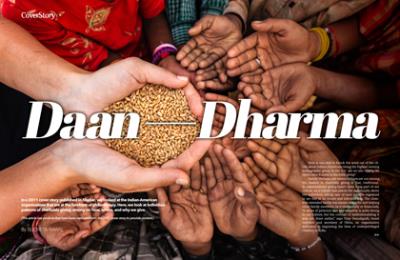
In a 2011 cover story published in Khabar, we looked at the Indian-American organizations that are at the forefront of philanthropy. Here, we look at individual patterns of charitable giving among us: how, where, and why we give.
(This article has portions that have been reprinted from the 2011 cover story to provide context.)
Here is one way to knock the wind out of the cliché about Indian-Americans being the highest earning demographic group in the U.S.: are we also topping the charts when it comes to charitable giving?
Hardly! Perhaps one reason Indians are not among the leaders in charitable giving is that, traditionally, organizational giving hasn’t been a big part of our culture. As a culture that places the community above the individual, taking care of each other is ingrained in us—but in an innate and informal way. The closeknit extended family has meant caring for and helping other family members, be it emotionally or financially. “A sense of personal care and empathy is quite strong in our culture, but the concept of institutionalizing it was not there earlier,” says Vijay Vemulapalli, board member and secretary of Vibha, an organization dedicated to improving the lives of underprivileged children in India.
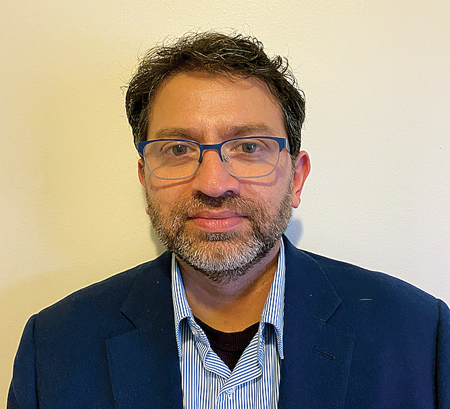
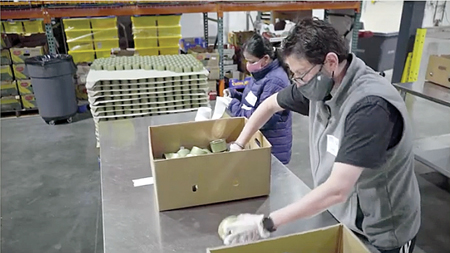
[Left] Ashish Shah, Senior Director of Philanthropy and Community Engagement at Indiaspora.
[Right] Shah, volunteering at Food Lifeline.
In the Indian way, charity has traditionally meant giving alms to beggars on the streets or donating money to temples and religious organizations. However, some wealthy industrialists in India, who have been around since pre-Independence, have been undertaking institutional philanthropic work. The Birla family is known for building several temples, besides setting up educational institutions such as the famous Birla Institute of Technology and Science (BITS) in Pilani. Tata, the other prominent business family from that time, has set up some notable hospitals, research institutions, and schools for higher learning. In fact, Jamshedji Tata has been named the world’s biggest philanthropist in the last century, ahead of Melinda and Bill Gates. But other than these very large but few examples, there is little formal infrastructure of professional charitable organizations in one of the world’s leading economies, with a population of over a billion people.
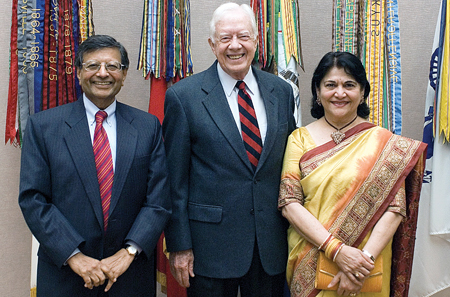
Atlanta’s own Madhu and Dr. Jagdish Sheth, with President Jimmy Carter, one of the nation’s most preeminent philanthropists.
Not surprisingly, when Indian immigrants first came to the U.S., they were often missing in action in the area of charitable giving. The first generation was primarily focused on settling in a new country and concentrating on education and career. They may have appeared uncharitable in a country where service and charity are quite visibly emphasized and institutionalized. The U.S. consistently ranks high in the list of Most Generous Countries. The average American sees volunteering and giving a portion of one’s wealth as good Christian traits. And even though the society is individualistic on many levels, there is also an overriding emphasis on the common good of the community. Americans see value in building shelters for the homeless, volunteering in soup kitchens, or even donating for disaster relief in far-off places.
According to a 2018 survey by Dalberg and Indiaspora, the estimated donation rate of Indian-Americans was 1.5 percent of income per year, compared with the American donation rate of 4 percent per year. This results in a “giving gap” of $2-3 billion between the current giving by the Indian diaspora versus what the donation figures would be if they matched the U.S. average.
One reason for this lag in giving is that as immigrants, we are first and foremost focused on professional and personal growth. Ashish Shah, Senior Director of Philanthropy and Community Engagement at Indiaspora believes, “The generation that came to the United States in the 1970-90s worked very hard to build their careers, accumulate wealth, support their immediate families, and help bring their extended families here. So, giving in a charitable sense was not a priority. But now these same families are looking to engage and contribute.”
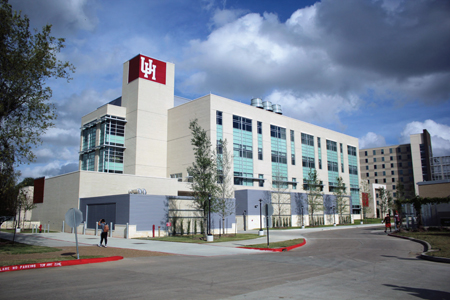
Causes we support
Historically, the Indian diaspora supported causes back home in India as well as local causes which had a connection to India, such as building community centers and places of worship. As a result, Jain temples, Sikh gurudwaras, and Hindu temples abound across the U.S. Many religions, including Jainism, preach that the possession of excess wealth is often self-destructive, and stress the importance of giving back. Even today, California-based philanthropist, Dr. Jasvant Modi concentrates on introducing the ancient faith of Jainism to students at American universities.
[Top] Durga D. and Sushila Agrawal Engineering Research Building at the University of Houston.
Change in giving habits
As Indian-Americans started to succeed professionally, they gave donations to educational institutes where they may have worked, studied, or sent their children. For example, the University of Houston renamed its engineering research building after the CEO of Piping Technology and Products, Durga D. Agrawal, and his wife, Shushila Agrawal, who gave a sizable donation. Florida’s Nova Southeastern University named two its medical schools, one each, after Tampa-based philanthropists, Dr. Kiran Patel and his wife Pallavi Patel. Similarly, chief executive officer of Noble Investment Group, Bharat Shah, endowed the Bharat Shah Leadership Speaker Series at Georgia State University. At Emory University, the Sheth Distinguished Lecture series is named in the honor of Madhu and Dr. Jagdish Sheth, whose generous donation makes the annual event possible.
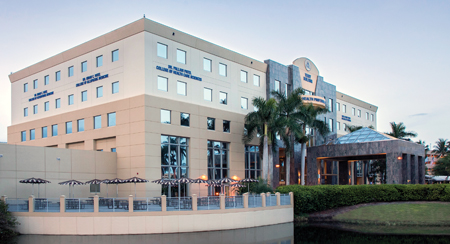
Dr. Pallavi Patel College of Health Care Sciences at the Nova Southeastern University in Fort Lauderdale, Florida.
Indians in the U.S. also fund medical research for diseases, often anchoring the funding to a university, medical school, or hospital. Trade professionals, such as doctors and lawyers, donate their time and talent to communities in India and in the U.S. They often join Doctors Beyond Borders, perform free cataract surgeries at camps in India, and offer pro bono legal advice to immigrants and refugees. Founded in 1982, the American Association of Physicians of Indian Origin (AAPI) has over 80,000 practicing members who support clean drinking water, childhood obesity awareness, tuberculosis, traumatic brain injury, and many other projects.
“Previously, we saw that Indians gave primarily to education, livelihood, and health; but in the past five-six years, this has changed,” says Ashish Shah. Several new causes such as civic engagement, rural development, climate change, hunger, and Black Lives Matter are resonating. People are realizing that they owe their success to their local communities and need to give where they live.
For Deepak Raghavan, Co-Founder and Director of Manhattan Associates, who is currently an adjunct professor and lecturer at Georgia State University, giving locally takes priority. “I grew up in Delhi and moved to the U.S. when I was 21 years old. I have been in Atlanta since 1995, and this is the city where I’ve spent more than half my life. I have created my professional and personal life in this community, which is why I feel a sense of loyalty to give back to the society I have benefited so much from,” says Raghavan.
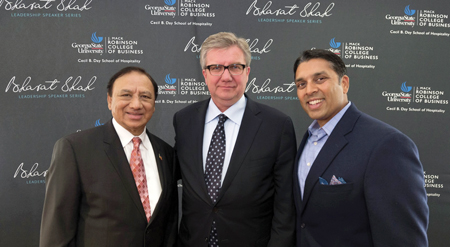
Raghavan and his wife, Priya, identified causes that were close to their hearts, which include education, animal conservation, and children’s health. They want to support multiple causes, some of which they have served on boards for. In 2001, they started a family foundation using personal assets and managing it on behalf of their extended family.
[Right] Chief Executive Officer of Noble Investment Group, Bharat Shah (left), endowed the Bharat Shah Leadership Speaker Series at Georgia State University.
Giving where you live
The Raghavans exemplify the shift in Indian-American giving habits. Approximately 90 percent of their foundation’s time and money goes to metro Atlanta-based organizations such as Georgia State University, Zoo Atlanta, Children’s Healthcare of Atlanta, and Shepherd Center, to name a few. The rest is dispersed towards an education project in India and an elephant conservatory in Africa—causes that they feel connected to personally.
After retiring from executive level jobs in corporate America, Raj G. Asava and Aradhana (Anna) Asava evaluated their bucket list and decided they wanted to spend the rest of their lives giving back in more meaningful ways. After speaking to their local mayor in Plano, Texas, they learned about the hunger epidemic in the U.S. and so, in 2017, they started Hunger Mitao movement with a mission to raise awareness about hunger issues. “We have lived here for 40 years and didn’t even know that kids who go to school with our own kids go hungry and don’t get nutritious meals. We had a moral obligation to do something,” says Anna. Since then, the full-time volunteer couple has helped provide over 40 million meals and opened chapters in six cities by engaging the four million-strong Indian diaspora in the U.S.
Strategic giving
When it comes to picking the charity to associate with, transparency is the most important factor donors look for. “Most Indians in the U.S. are highly educated and logical. But as immigrants, we also understand the value of a hard-earned dollar. That’s why we don’t just write checks without first asking questions,” says Raj Asava, who designed Hunger Mitao as a transparent volunteer-driven movement, and not an NGO funneling money.
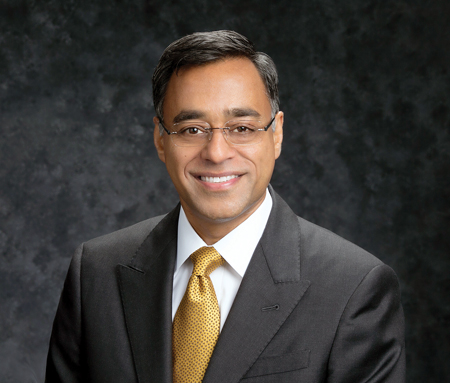
Raghavan too, emphasizes giving to organizations only after doing due diligence and committing to them long term. “Money is only one aspect. We also offer time and talent to ensure their success,” he adds. One of the best ways to see the returns on donated investments is by serving on board and by volunteering with the causes you donate to. Also, by getting to know the leaders who run the organizations, you have visibility of their work,” says he.
“I have been in Atlanta since 1995, and this is the city where I’ve spent more than half my life. I have created my professional and personal life in this community, which is why I feel a sense of loyalty to give back to the society I have benefited so much from,” says Deepak Raghavan about his philanthropic work.
Changing perceptions
Indian-Americans have expanded their philosophy of giving from family and community to broader causes across the world. Their views are changing. They are recognizing the fact that they have been able to create their wealth due to the educational, professional, and entrepreneurial opportunities offered by their adopted country. “We are no longer foreign immigrants but are living and thriving members of this diverse community, and have a responsibility to give back,” the Asavas add. Indian-Americans are slowly emerging as an empathetic and influential group that also gives where they live. They are moving away from the perception of being a gold-hoarding and freeloading community who mostly support their own Indian projects.
Building a culture of philanthropy among Indian-Americans would also lead to greater acceptance of the community. Inevitably, there is soft power that comes bundled with this position. Clearly, building a positive brand is important to affluent and influential Indians residing abroad. But today’s youth is also conscious about assimilating, and does so by participating in projects through their schools, universities, and neighborhoods. While they may not have much savings, they give through non-monetary means.
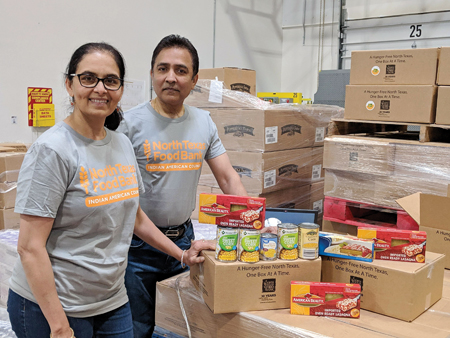
“We are no longer foreign immigrants but are living and thriving members of this diverse community, and have a responsibility to give back,” say Raj and Aradhana Asava, founders of Hunger Mitao, a volunteer-based organization fighting hunger in the United States.
Covid-19 has changed people’s attitude towards giving. It captured the world’s attention and touched almost everyone on a personal level. It pushed people to think beyond themselves, to question life’s purpose, and make an impact. Indiaspora’s “ChaloGive for COVID-19” initiative to fight hunger reached its initial goal of $1 million in just ten days from launch with an outpouring of support from the diaspora community in 2020.
Bright future
While we may be becoming more charitable as a community, we still need to be convinced about the cause and the right vehicle for maximum impact. “People have a desire to give. We just need to identify them at the right stage of their journey and provide them appropriate education around it,” says Shah who is positive about the future of giving. Once people understand what they care about, they need to assess how much they can give. Then they can look for existing organizations that do great work and learn more about them.
Still, more people can give time and money. Charity is no longer the exclusive domain of billionaires. “A large ‘middle of the pyramid’ is developing that is made up of intermediaries, catalysts, and changemakers,” Shah notes. We need to look at role models, lead by example, and work together across faiths and regional groups to address larger needs.
Dr. Sheth puts in the last word, “The more you give, the more empathy you learn to have, and that’s how you change yourself for the better.”
SUCHETA RAWAL is an award-winning Atlanta-based food and travel writer who also founded the nonprofit organization, Go Eat Give.
Enjoyed reading Khabar magazine? Subscribe to Khabar and get a full digital copy of this Indian-American community magazine.
blog comments powered by Disqus










